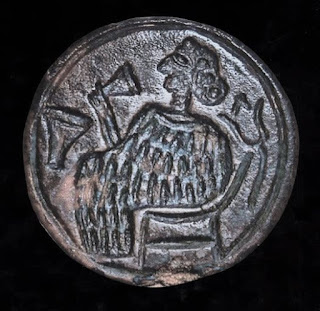Tulips grow wild in Central Asia and bloom in Spring...So who's the goddess? The zigzag and wavy lines at the top usually represent flowing water. So is the goddess somehow linked with the flowing water?
Bactria was centered around the upper reaches of Amu Darya (Oxus River). This river was fed
Amu Darya (Oxus River) is partially fed by the rain that falls during the cool, wet half of the year (Oct/Nov-Apr/May)...
Climate Tajikistan
Climate Uzbekistan
But the majority of the water in the river comes from the snowmelt from the Hindu Kush, Tian Shan and Pamirs mountains.
Total snow melt contribution is between 65 and 72%...
You can read more about this in "Runoff from glacier ice and seasonal snow in High Asia: separating melt water sources in river flow"
The annual Amu Darya water level chart.
The water level starts rising sharply in Feb, at the beginning of the snowmelt season. Now you know why Aquarius 🙂 water pourer, is where it is on the zodiac.
The water flow peaks in May. In Taurus, and then sharply decreases...
This rising of the water level, which enables irrigation and agriculture in the area, happens during the tulip flowering season...So tulips are definitely linked with flowing water...
I talked more about tulips as calendar markers in Bactria in my post "Sumer and winter BMAC seal"...
So who is the goddess? Earth...Mother Earth...Young, virgin, spring earth...Who just had her first period...So let me introduce you to: Aunt Flo...🙂
This could be the same girl. From a Bactrian seal: Mother earth flowering with tulips next to the flowing river. The snake is under ground (cold part of the year) and the Goitered gazelle (whose mating coincides with the beginning of the cool wet season) is looking at the amazing effect of "the rain it has brought"...I talked about this in my post "Fluffy"...
I wander if this girl has anything to do with Iranian Anahita, the goddess of water...Which features on Iranian artifacts since at least Jiroft culture...The Annual water cycle is identical, so...I talked about it in my post "Anahita"...



















This is really fascinating. Thank you for sharing this. I have been doing a lot of research on tulip history, and so far the oldest visual reference I was aware of was a golden garment patch with tulip motifs from the 3rd/2nd century BC which was found in a burial mound in Kazakhstan. It was related to the Saka people (Scythians). I also found Sassanian silver vessels from the 6th century AD of a goddess or dancer with tulips from the 6th century, which might be related to the goddess you're discussing. Happy to share more, and interested to explore this topic further with you. feel free to contact me. Ibo Gülsen.
ReplyDelete